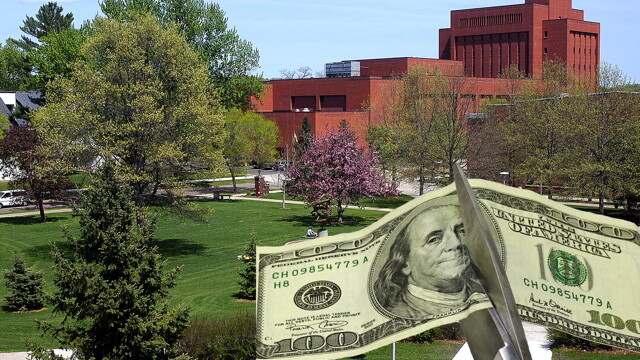School's Out
how the state budget lapse will affect our universities

It seems like every fall when state, federal, and local budgets need to be completed, uncertainty begins to build when tough decisions (namely cuts) are made. And right now a lot of uncertainty is being felt by the UW System, including our very own universities of UW-Stout and UW-Eau Claire, which are forced to make several million dollars worth of cuts in the coming weeks.
“The outcome of this is students will see classes closer to capacity because of fewer sections,” said Dave Gessner, assistant chancellor for budget and finance at UWEC. “Elsewhere we’ll see fewer part-time staff and fewer employees in general. We’ve had to make more than $4 million in cuts this year – the most in a single year ever here – and so far we’ve avoided lay-offs, but we know we’ll have to have fewer employees.”
“In 2001, the state provided 64% of our operating budget while tuition ... comprised 36%. In 2011, those percentages are essentially reversed.”
– UWEC Chancellor Brian Levin-Stankevich
After already reducing its base budget by $250 million because of the state budget lapse, last month the UW System again came under fire when it was announced that they would need to cut between $65.7 million and $113.2 million on top of that. The proposed cuts affect all of the state schools under the UW System umbrella for their 2011-13 budgets. Some have argued the cuts are unfairly targeting education, since the UW System is absorbing 38% of the lapse when it only accounts for 7% of the total budget. The UW System and their schools are continuing to appeal to the state to reconsider their portion, so we won’t know for sure what the exact dollar amount in cuts will be for a few weeks. What we do know is that these cuts to education have been a trend for roughly a decade now.
“In 2001, the state provided 64% of our operating budget while tuition paid by students and their families comprised 36%,” UWEC Chancellor Brian Levin-Stankevich wrote in an email to students and faculty recently. “In 2011, those percentages are essentially reversed. Tuition now provides 67% of our operating budget and the state 33%.”
Local institutions UW-Stout and UWEC are handling these cuts similar to others, by spreading out the reductions through all departments instead of allowing major setbacks in certain areas, officials from each have said.
But because the lapse incorporates this fiscal year, campuses are struggling to raise revenue from money they’ve already begun to spend. When universities planned for the cuts imposed this past spring, they didn’t know more would be coming mid-semester. As such, both the UWEC and Stout chancellors have approved dipping into their emergency reserve funds by as much as 50% to get through 2011.
Local institutions UW-Stout and UWEC are handling these cuts similar to others, by spreading out the reductions through all departments instead of allowing major setbacks in certain areas, officials from each have said.
But because the lapse incorporates this fiscal year, campuses are struggling to raise revenue from money they’ve already begun to spend. When universities planned for the cuts imposed this past spring, they didn’t know more would be coming mid-semester. As such, both the UWEC and Stout chancellors have approved dipping into their emergency reserve funds by as much as 50% to get through 2011.
At UW-Stout, there is presently a hiring freeze and the slowing/stopping of major equipment purchases. From this budget lapse, UW-Stout could be responsible for a range of $2.6 million to $4.4 million in cuts. The atmosphere on campus is, as UW-Stout Director of University Communications Doug Mell says, “uncertain and nervous.”
When asked how students will be directly impacted, Mell said, “Could we see some areas with bigger class sizes? Could we see less availability of services like counseling and advising? It’s possible.”
UWEC’s portion of this lapse is approximately $2.3 million. UWEC plans to concentrate on offering all courses needed to graduate on time, including general education requirements. In addition, each major’s classes and the electives favored by most students will continue to be provided, though there will be a decrease in the number of class sections and classes that fail to reach a certain enrollment may be at risk.
“We’ll try to avoid things that delay graduation goals, so we don’t ruin people’s academic plan,” Gessner said. “That is the biggest impact students will see. But another impact, longer term, is the vacancies we have now and will have in the future – we’ll be more selective how, when, and if we fill them.”
Each school has addressed the fact that at least 80% of their budgets are personnel. While Stout has stated that it is not their intention at this point to lay off anyone, Levin-Stankevich’s message to faculty states, “We will continue to review every vacancy that occurs to determine if it should be filled – or if there are ways to rethink responsibilities. Not filling open positions and cutting overloads and release time will be the first options, but lay-offs cannot be ruled out.”
As it has done for the past decade, tuition will likely increase for students next year, but no more than the allowed cap of 5.5%. Both schools are committed to providing their students not only with the highest quality education. However some school officials are openly challenging Gov. Scott Walker, saying stretching our university’s budgets at a critical time when student enrollment is at its peak is threatenening Wisconsin’s reputation and ability to provide that high quality.
For more information please refer to: uwec.edu/News/more/statebudget.htm and uwstout.edu/asls/budget.cfm or wisconsin.edu/news.




















